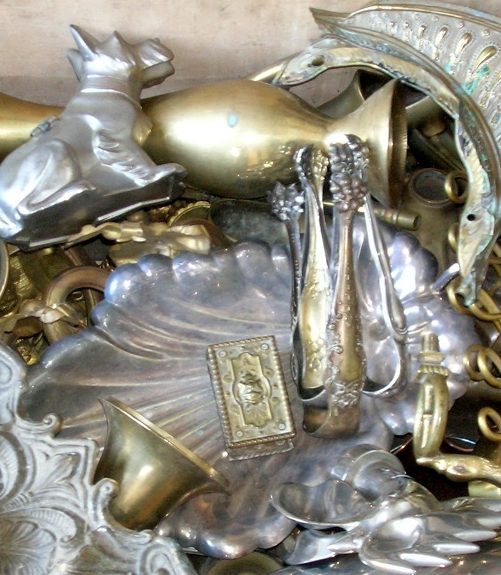



Head, heart and hands.
In Peter’s head resides a residue of mythology, religion, fairy tales and dreams. During his work thoughts, distorted sayings and garbled proverbs well up from these sources. Interacting with his hands a puzzle emerges with separate components that should result in a credible assemblage. Most of the time he ends up with curious creatures that seem to want to say something. Often they refer to the human condition. Some of the seven deadly sins – sung so beautifully by Lotte Lenya on texts by Kurt Weill – play the leading part: pride, wrath and greed.
Death has always played an intriguing role in the artist’s life. From finding a dead bird and a dying squirrel as a young boy, to playing soldier with a wooden sword and shouting ‘kill’ or lying on the ground pretending to be slain. The more grown-up interest in death began when reading about the battle in which King Arthur died and thereafter about the Trojan War, the Crusades and the Great War. It was not heroism that struck him. It was the complete uselessness of so many victims, as if nature was not cruel enough. It raised an important question. What ideals urge people to march behind a king, a dictator, a prophet or a false prophet, even if death is the consequence? The installation The False Prophet, surrounded by six deathlike figures, is the artist’s very personal means to cope with death. Nobody knows what it means to be dead. We can only guess, but we cannot tolerate the thought that there is nothing behind it. ‘Nothing’ is beyond our imagination, as M.C. Escher stated. We stare into the universe and try to imagine where it ends. Can it end into nothing? Can our lives end into nothing? So why are we here anyway? That is why people of every culture, cult or religion try to imagine something that seems to make sense, give meaning, whether it be heaven, hell or resurrection.
Through the acquisition of beautiful tiny porcelain skulls in Spain, Death entered Peter’s work. It was very tempting to make grim work now and to infuse it with a moral: ‘Memento Mori’. But it is the very challenge to construct these assemblages in such a way that they invite the viewer to discover the different perspective, hidden meanings and humour of which they are the exponent. The False Prophet is meant as a modest contribution to all that has been expressed about death.
Hoofd, hart en handen
In mijn hoofd huist een bezinksel van mythologie, religie, sprookjes en dromen. Uit die bronnen wellen tijdens mijn werk gedachten op, vaak in de vorm van verbasterde gezegdes en verminkte spreuken. In samenspel met mijn handen ontstaat een puzzel met losse onderdelen die moet uitmonden in een geloofwaardige assemblage. Meestal kom ik uit op min of meer menselijke of dierlijke gestalten, wonderlijke wezens die ons iets lijken te willen vertellen. Soms hebben ze vleugels, zelden hebben ze armen én benen, hun kop kan van alles zijn. Een enkele maal krijgen ze – naar goed katholiek gebruik – een attribuut mee, zoals een zwaard, een sieraad, een ei of een kikker.
De eerste sculptuur vervaardigde ik in een opwelling uit koperdraad, een grote, glazen kraal en een stukje kerstversiering. ‘Danseresje’ werd haar naam. Al snel kreeg ze gezelschap van vreemde wezens die mij bij het vervaardigen ervan hun naam leken in te fluisteren. Toen Aapje Grijpgraag het licht zag, en daarna Windbuil en Willen Is Kunnen, kregen de beeldjes meer betekenis. Ze verwezen naar het menselijk tekort.
Van de zeven doodszonden – zo prachtig bezongen door Lotte Lenya op teksten van Kurt Weil – spelen enkele de hoofdrol: hoogmoed, woede en hebzucht. Aapje Grijpgraag laat zijn glimmende vangst niet los en blijft daardoor gevangen, Windbuil met haar transparante, glazen lichaam ademt ondanks haar juwelen niets dan leegheid, Willen Is Kunnen is gevangen in een moeras van medailles.
Met de aankoop van prachtige porseleinen schedeltjes in Spanje deed de Dood zijn intrede in mijn werk. Het is heel verleidelijk om nu grimmig werk te maken en dat op te laden met een moraal: “Gedenk te sterven!”. Maar de uitdaging is juist om mijn assemblages zo te vervaardigen dat ze de kijker uitnodigen om de relativering, dubbele bodems en humor te ontdekken waarvan zij de vertolker zijn.
Short Artist Statement in English
An alpha-mind with bèta-hands. Autodidact in drawing and making sculptures. My work is a kind of storytelling. Without ignoring intellect or knowledge I aim to evoke my hidden memories. Like in a stream of consiousness in writing fiction, I aim to materialise a multitude of impressions emerging in my mind while working.
